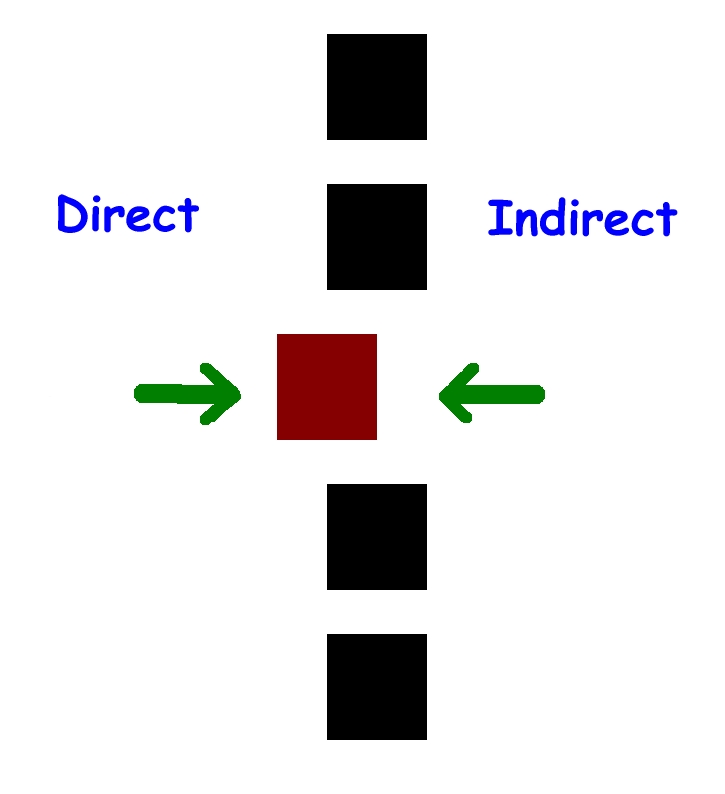In the world of bodywork, one could separate techniques into direct techniques and indirect techniques. Arguments about which ones you should use are fairly intense. It is like talking about Jesus or Oprah or Abortion; If you’ve got the other opinion, you know that you’re asking for a fight if you start talking about it. I will go out on a limb and post something about this, as I can see that I will want to refer to this in other posts.
Practical Application

Similarities
First, let’s talk about how they are similar. Both of them determine the direction of “ease” and the direction of “bind.” The structure is then taken through a range of motion in one direction or the other until there is a change in the quality/quantity of motion. There are variations on this idea, but this is basically it.
Differences
This illustration represents a stack of vertebrae. The red one has eased off to the left. It binds when
moved back to theright and into alignment with the other vertebrae.
- Direct technique would push it to the back toward alignment.
- Indirect technique would push it away from alignment.
Muscular Technqiues
We could take this same concept and apply it to lengthening muscles.
- Strain-counter strain is an indirect technique. It moves the ends of the muscle toward each other until it relaxes. Once they relax, the muscle can lengthen more than before treatment.
- Most stretching techniques are direct techniques. They attempt to lengthen muscles by pulling the ends away from each other until the muscle is longer than before treatment.
Conceptual Differences
This is very important to many practitioners. This speaks to the intent of intervention. It also implies that the role of the patient is more active or passive in their healing process.
Direct technique
Direct technique is when the practitioner organizes things and corrects form. The practitioner cleans up the mess so the body can get on with orderly function. In other words, it is about removing challenges to make it easier for the body to function. This is closely associated with structural techniques and the idea that structure dictates function. In this approach, the practitioner fixes the problem directly. You could compare this to taking antibiotics, removing a mole, or wearing glasses.
Analogy: Your therapist gives you a supply of delicious ready-to-eat fish because you’re hungry.
Direct technique is seen as:
- more difficult to release,
- more focused on the quantity of movement,
- balances movement by expanding restricted ranges,
- modifies the structure to be more organized,
- better able to resolve chronic conditions,
- strongly associated with structural technique.
Indirect technique
Indirect technique is where the practitioner disorganizes things and gently exaggerates the problem. The practitioner makes the mess a little more challenging so that the body responds by starting its own process to create order. In other words, we want to create a reaction that starts the process and so that the body learns to fix itself. In this approach, you start fixing yourself because your system has been gently challenged. You could compare this to vaccinations, homeopathic medicine, or vision therapy.
Analogy: your therapist talks about your hunger and until you are compelled to get some fish.
Indirect technique is seen as:
- easier to release,
- more focused on the quality of movement,
- balances movement more than expanding it,
- safer for acute injuries and the novice practitioner
- strongly associated with functional technique
Structure vs. Function – Should We Clean-up or Remodel?
I like to compare these two approaches to dealing with a cluttered house.

Functional Technique
Functional Technique is about reorganizing. It tends to create relief more than lasting change. Instead of putting things up and cleaning off the surfaces, bodyworkers do things like mobilize joints, give you exercises, balance tension, and release trigger points.
This is based on the physiological principle that form follows function. It is about changing the behavior between structures so that function is balanced.
Form Follows Function
If you use something a certain way, it will cause the structure to remodel or adapt. This can be good or bad. This means that iron skillets get seasoned, and carpets wear out in the most used path. In our bodies, muscles, and bones get stronger when we get regular exercise. Also, joints get damaged when they exercise improperly or ossify when there is insufficient exercise.
In bodywork, these techniques tend to be lighter, and quicker. Practitioners and patients favor them because they create quick relief.
Functional technique is seen as:
- modifies the relationships between structures
- creates better neurological coordination,
- balances movement more than expanding it,
- breaks up facilitated neurological pathways,
- is safer in acute injuries
- easier for the novice practitioner

Structural Technique
Structural technique is about remodeling. It tends to create lasting improvement instead of relief. Instead of moving walls and resurfacing floors, bodyworkers lengthen fascia and suggest supplements that rebuild joints.
This is based on the idea that structure dictates function. For example, when the connective tissue is lengthened, it will allow the joint to have a greater range of motion. Structural technique is about changing the shape and/or length of the structure to make new functions possible.
Structure Dictates Function
Structural restrictions can limits function. This means you are cramped, doors jam, floors wobble, and drawers won’t stay closed in a house. In our bodies, this means that joints bind so that you are unsteady and hurt. Muscles tense to protect those binding joints. Ligaments and tendons don’t lengthen to allow proper movement without inflammation and pain.
Among other things, structural techniques make functional techniques easier, more effective, and longer lasting.
Structural technique is seen as:
- modifying the shape and length of structures,
- balancing movement by expanding the restricted motion,
- creates new possibilities for movement,
- creates longer-term changes,
- takes longer to treat
- is more difficult for the practitioner
Support Integrative Works to
stay independent
and produce great content.
You can subscribe to our community on Patreon. You will get links to free content and access to exclusive content not seen on this site. In addition, we will be posting anatomy illustrations, treatment notes, and sections from our manuals not found on this site. Thank you so much for being so supportive.
Cranio Cradle Cup
This mug has classic, colorful illustrations of the craniosacral system and vault hold #3. It makes a great gift and conversation piece.
Tony Preston has a practice in Atlanta, Georgia, where he sees clients. He has written materials and instructed classes since the mid-90s. This includes anatomy, trigger points, cranial, and neuromuscular.
Question? Comment? Typo?
integrativeworks@gmail.com
Interested in a session with Tony?
Call 404-226-1363
Follow us on Instagram

*This site is undergoing significant changes. We are reformatting and expanding the posts to make them easier to read. The result will also be more accessible and include more patterns with better self-care. Meanwhile, there may be formatting, content presentation, and readability inconsistencies. Until we get older posts updated, please excuse our mess.


Comments are closed.